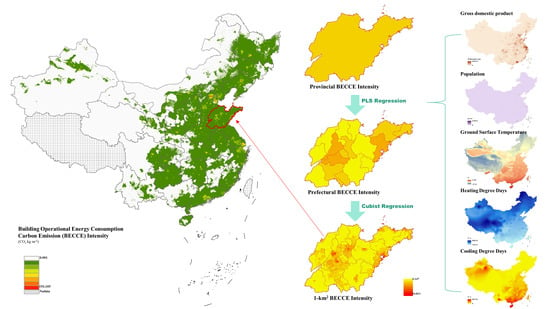Downscaling Building Energy Consumption Carbon Emissions by Machine Learning
Abstract
:1. Introduction
2. Methodology
2.1. Calculating Provincial-Level BECCE from Different Sources
2.2. Selection of Predictors for BECCE Mapping
2.3. Building Provincial-Level PLS Regression Models
2.4. Building Cubist Regression Models
3. Application and Verification
3.1. Data and Preprocessing
3.2. Results
3.2.1. Spatial Distribution of the Five Covariates
3.2.2. Energy Usage and Carbon Emissions at the Provincial Level from Energy-Balance Calculation
3.2.3. Building PLS Regression Models for Provincial-Level BECCE
3.2.4. Pixel-Based Distribution of BECCE Intensity
3.2.5. Comparative Assessment of Accuracy
4. Discussion
4.1. Advantages of the Method
4.2. Comparison of Normalized BECCE Intensity and AHFb for Eight Metropolitan Cities in China
4.3. Limitations
5. Conclusions
Author Contributions
Funding
Institutional Review Board Statement
Informed Consent Statement
Data Availability Statement
Acknowledgments
Conflicts of Interest
Appendix A
| Abbreviation | Definition | Abbreviation | Definition |
|---|---|---|---|
| BECCE | Building operational energy consumption carbon emissions | BECCEI | building operational energy consumption carbon emission intensity |
| UN | United Nations | AHFb | anthropogenic heat flux |
| SDGs | Sustainable Developments Goals | POP | population |
| RECS | Residential Energy Consumption Surveys | GDP | gross domestic product |
| CBECS | Commercial Buildings Energy Consumption Surveys | HDD18 | heating degree days |
| EIA | Energy Information Administration | CDD26 | cooling degree days |
| ECUK | Energy Consumption in the UK | GST | ground surface temperature |
| PLS | partial least squares regression |
References
- Liu, Y.; Wang, M.; Feng, C. Inequalities of China’s regional low-carbon development. J. Environ. Manag. 2020, 274, 1–11. [Google Scholar] [CrossRef]
- Zhang, Y.; Zhao, L.; Zhang, H.; Tan, T. The impact of economic growth, industrial structure and urbanization on carbon emission intensity in China. Nat. Hazards 2014, 73, 579–595. [Google Scholar] [CrossRef]
- Flückiger, M.; Ludwig, M. Geography, human capital and urbanization: A regional analysis. Econ. Lett. 2018, 168, 10–14. [Google Scholar] [CrossRef] [Green Version]
- Energy Information Administration. 2019 Global Status Report for Buildings and Construction; United Nations Environment Programme: Washington, DC, USA, 2019. [Google Scholar]
- Ramaswami, A.; Tong, K.; Canadell, J.; Jackson, R.; Stokes, E.; Dhakal, S.; Finch, M.; Jittrapirom, P.; Singh, N.; Yamagata, Y.; et al. Carbon analytics for net-zero emissions sustainable cities. Nat. Sustain. 2021, 4, 460–463. [Google Scholar] [CrossRef]
- Energy Information Administration. GlobalABC Roadmap for Buildings and Construction 2020–2050; Federal Ministry of Economic Affairs and Energy: Washington, DC, USA, 2020.
- Sztubecka, M.; Skiba, M.; Mrówczyńska, M.; Bazan-Krzywoszańska, A. An innovative decision support system to improve the energy efficiency of buildings in urban areas. Remote Sens. 2020, 12, 259. [Google Scholar] [CrossRef] [Green Version]
- Yang, X.; Zhao, L. Impacts of urban microclimate on building energy performance: A review of research methods. Build. Sci. 2015, 31, 1–7. [Google Scholar]
- Shahrestani, M.; Yao, R.; Luo, Z.; Turkbeyler, E.; Davies, H. A field study of urban microclimates in London. Renew. Energy 2015, 73, 3–9. [Google Scholar] [CrossRef] [Green Version]
- Li, J.; Colombier, M. Managing carbon emissions in China through building energy efficiency. J. Environ. Manag. 2009, 90, 2436–2447. [Google Scholar] [CrossRef]
- Kahn, M.; Kok, N.; Quigley, J. Carbon emissions from the commercial building sector: The role of climate, quality, and incentives. J. Publ. Econ. 2014, 113, 1–12. [Google Scholar] [CrossRef]
- Eggleston, H.; Buendia, L.; Miwa, K.; Ngara, T.; Tanabe, K. 2006 IPCC Guidelines for National Greenhouse gas Inventories; IPCC National Greenhouse Gas Inventories Programme: Washington, DC, USA, 2006; pp. 1–20. [Google Scholar]
- Kadir, A.; Nora, M. A review of data-driven building energy consumption prediction studies. Renew. Sustain. Energy Rev. 2018, 81, 1192–1205. [Google Scholar]
- Zhao, H.; Magoules, F. A review on the prediction of building energy consumption. Renew. Sustain. Energy Rev. 2012, 16, 3586–3592. [Google Scholar] [CrossRef]
- Yang, X.; Peng, L.L.H.; Jiang, Z.; Chen, Y.; Yao, L.; He, Y.; Xu, T. Impact of urban heat island on energy demand in buildings: Local climate zones in Nanjing. Appl. Energy 2020, 260, 1–13. [Google Scholar] [CrossRef]
- Fumo, N.; Mago, P.; Luck, R. Methodology to estimate building energy consumption using EnergyPlus Benchmark Models. Energy Build. 2010, 42, 2331–2337. [Google Scholar] [CrossRef]
- Xu, P.; Huang, Y.J.; Miller, N.; Schlegel, N.; Shen, P. Impacts of climate change on building heating and cooling energy patterns in California. Energy 2012, 44, 792–804. [Google Scholar] [CrossRef]
- Strachan, P.; Kokogiannakis, G.; Macdonald, I. History and development of validation with the ESP-r simulation program. Build. Environ. 2008, 43, 601–609. [Google Scholar] [CrossRef] [Green Version]
- Zhou, W.; Moncaster, A.; Reiner, D.M.; Guthrie, P. Developing a generic System Dynamics model for building stock transformation towards energy efficiency and low-carbon development. Energy Build. 2020, 224, 1–17. [Google Scholar] [CrossRef]
- Ye, H.; Pan, L.; Chen, F.; Wang, K.; Huang, S. Direct carbon emission from urban residential energy consumption: A case study of Xiamen, China. Acta Ecol. Sin. 2010, 30, 3802–3811. [Google Scholar]
- EIA. 2018 Commercial Buildings Energy Consumption Survey; U.S. Department of Energy: Washington, DC, USA, 2021.
- Department for Business, Energy& Industrial Strategy. Energy Consumption in the UK (ECUK) 1970 to 2020. Available online: https://assets.publishing.service.gov.uk/government/uploads/system/uploads/attachment_data/file/1021836/Energy_Consumption_in_the_UK_2021.pdf (accessed on 30 September 2021).
- Huo, T.; Ma, Y.; Yu, T.; Cai, W.; Liu, B.; Ren, H. Decoupling and decomposition analysis of residential building carbon emissions from residential income: Evidence from the provincial level in China. Environ. Impact Assess. Rev. 2021, 86, 1–12. [Google Scholar] [CrossRef]
- Li, D.; Huang, G.; Zhang, G.; Wang, J. Driving factors of total carbon emissions from the construction industry in Jiangsu Province, China. J. Cleaner Prod. 2020, 276, 1–14. [Google Scholar] [CrossRef]
- Liu, Z. Near-real-time monitoring of global CO2 emissions reveals the effects of the COVID-19 pandemic. Nat. Commun. 2020, 11, 1–12. [Google Scholar] [CrossRef] [PubMed]
- Stevens, F.; Gaughan, A.; Linard, C.; Tatem, A. Disaggregating census data for population mapping using Random Forests with remotely-sensed and ancillary data. PLoS ONE 2015, 10, e0107042. [Google Scholar] [CrossRef] [PubMed] [Green Version]
- Jin, C.; Zhang, X.; Yang, X.; Zhao, N.; Ouyang, Z.; Yue, W. Mapping China’s electronic power consumption using points of interest and remote sensing data. Remote Sens. 2021, 13, 1058. [Google Scholar] [CrossRef]
- Chen, Q.; Yang, X.; Ouyang, Z.; Zhao, N.; Jiang, Q.; Ye, T.; Qi, J.; Yue, W. Estimation of anthropogenic heat emissions in China using Cubist with points-of-interest and multisource remote sensing data. Environ. Pollut. 2020, 266, 1–10. [Google Scholar] [CrossRef] [PubMed]
- Ge, Y.; Jin, Y.; Stein, A.; Yuehong, C.; Wang, J.; Wang, J.; Cheng, Q.; Bai, H.; Liu, M.; Atkinson, P.M. Principles and methods of scaling geospatial Earth science data. Earth-Sci. Rev. 2019, 197, 1–17. [Google Scholar] [CrossRef]
- Liao, Y.; Wang, J.; Meng, B.; Li, X. A method of spatialization of statistical population. Acta Geogr. Sin. 2007, 62, 1110–1119. [Google Scholar]
- Liao, Y.; Li, D.; Zhang, N. Comparison of interpolation models for estimating heavy metals in soils under various spatial characteristics and sampling methods. Trans. GIS 2018, 22, 409–434. [Google Scholar] [CrossRef]
- Department of Energy Statistics, National Bureau of Statistics, People’s Republic of China. China Energy Statistical Yearbook 2016; China Statistics Press: Beijing, China, 2016. [Google Scholar]
- Li, W.; Zhou, Y.; Cetin, K.; Eom, J.; Wang, Y.; Chen, G.; Zhang, X. Modeling urban building energy use: A review of modeling approaches and procedures. Energy 2017, 141, 2445–2457. [Google Scholar] [CrossRef]
- Ye, H.; Ren, Q.; Shi, L.; Song, J.; Hu, X.; Li, X.; Zhang, G.; Lin, T.; Xue, X. The role of climate, construction quality, microclimate, and socio-economic conditions on carbon emissions from office buildings in China. J. Clean. Prod. 2018, 171, 911–916. [Google Scholar] [CrossRef]
- Ye, H.; Qiu, Q.; Zhang, G.; Lin, T.; Li, X. Effects of natural environment on urban household energy usage carbon emissions. Energy Build. 2013, 65, 113–118. [Google Scholar] [CrossRef]
- Timmons, D.; Zirogiannis, N.; Lutz, M. Location matters: Population density and carbon emissions from residential building energy use in the United States. Energy Res. Soc. Sci. 2016, 22, 137–146. [Google Scholar] [CrossRef]
- Ye, H.; Wang, K.; Zhao, X.; Chen, F.; Li, X.; Pan, L. Relationship between construction characteristics and carbon emissions from urban household operational energy usage. Energy Build. 2011, 43, 147–152. [Google Scholar] [CrossRef]
- Delmastro, C.; Mutani, G.; Schranz, L.; Vicentini, G. The role of urban form and socio-economic variables for estimating the building energy savings potential at the urban scale. Int. J. Heat Technol. 2015, 33, 91–100. [Google Scholar] [CrossRef]
- Shi, K.; Yu, B.; Zhou, Y.; Chen, Y.; Yang, C.; Chen, Z.; Wu, J. Spatiotemporal variations of CO2 emissions and their impact factors in China: A comparative analysis between the provincial and prefectural levels. Appl. Energy 2019, 233-234, 170–181. [Google Scholar] [CrossRef]
- Yang, L.; Yan, H.; Lam, J.C. Thermal comfort and building energy consumption implications—A review. Appl. Energy 2014, 115, 164–173. [Google Scholar] [CrossRef]
- Skelhorn, C. A Fine Scale Assessment of Urban Greenspace Impacts on Microclimate and Building Energy in Manchester. Ph.D. Thesis, The University of Manchester, Manchester, UK, 2013. [Google Scholar]
- Ye, H.; Hu, X.; Ren, Q.; Lin, T.; Li, X.; Zhang, G.; Shi, L. Effect of urban micro-climatic regulation ability on public building energy usage carbon emission. Energy Build. 2017, 2017, 553–559. [Google Scholar] [CrossRef]
- Wold, S.; Sjostrom, M.; Eriksson, L. PLS-regression: A basic tool of chemometrics. Chemom. Intell. Lab. Syst. 2001, 58, 109–130. [Google Scholar] [CrossRef]
- Geladi, P.; Kowalski, B.R. Partial least-squares regression: A tutorial. Anal. Chim. Acta 1986, 185, 1–17. [Google Scholar] [CrossRef]
- Carrascal, L.M.; Galvan, I.; Gordo, O. Partial least squares regression as an alternative to current regression methods used in ecology. Oikos 2009, 118, 681–690. [Google Scholar] [CrossRef]
- Wan, K.K.W.; Li, D.H.W.; Yang, L.; Lam, J.C. Climate classifications and building energy use implications in China. Energy Build. 2010, 42, 1463–1471. [Google Scholar] [CrossRef]
- Nagle, N.N.; Buttenfield, B.P.; Leyk, S.; Speilman, S. Dasymetric modeling and uncertainty. Ann. Assoc. Am. Geogr. 2014, 104, 80–95. [Google Scholar] [CrossRef] [Green Version]
- Jia, P.; Gaughan, A.E. Dasymetric modeling: A hybrid approach using land cover and tax parcel data for mapping population in Alachua County, Florida. Appl. Geogr. 2016, 66, 100–108. [Google Scholar] [CrossRef]
- Quinlan, J.R. Learning with Continuous Classes, 1. In Proceedings of the 5th Australian Joint Conference on Artificial Intelligence, Hobart, Tasmania, 16–18 November 1992; pp. 343–348. [Google Scholar]
- Quinlan, J.R. Combining instance-based and model-based learning, 1. In Proceedings of the Tenth International Conference on Machine Learning, Amherst, MA, USA, 27–29 June 1993; pp. 236–243. [Google Scholar]
- Kuhn, M.; Johnson, K. Applied Predictive Modeling; Springer: New York, NY, USA, 2013; pp. 208–212. [Google Scholar]
- Zhou, J.; Li, E.; Wei, H.; Li, C.; Qiao, Q.; Armaghani, D.J. Random forests and Cubist algorithms for predicting shear strengths of rockfill materials. Appl. Sci. 2019, 9, 1621. [Google Scholar] [CrossRef] [Green Version]
- Noi, P.T.; Degener, J.; Kappas, M. Comparison of multiple linear regression, Cubist regression, and random forest algorithms to estimate daily air surface temperature from dynamic combinations of MODIS LST data. Remote Sens. 2017, 9, 398. [Google Scholar] [CrossRef] [Green Version]
- Houborg, R.; McCabe, M.F. A hybrid training approach for leaf area index estimation via Cubist and random forests machine-learning. ISPRS J. Photogramm. Remote Sens. 2018, 135, 173–188. [Google Scholar] [CrossRef]
- Xu, Y.; Ho, H.C.; Wong, M.S.; Deng, C.; Shi, Y.; Chan, T.-C.; Knudby, A. Evaluation of machine learning techniques with multiple remote sensing datasets in estimating monthly concentrations of ground-level PM2.5. Environ. Pollut. 2018, 242, 1417–1426. [Google Scholar] [CrossRef]
- Taylor, B.L. Population-weighted heating degree-days for Canada. Atmos.-Ocean 1981, 19, 261–268. [Google Scholar] [CrossRef] [Green Version]
- Shi, Q.; Gao, J.; Wang, X.; Ren, H.; Cai, W.; Wei, H. Temporal and spatial variability of carbon emission intensity of urban residential buildings: Testing the effect of economics and geographic location in China. Sustainability 2020, 12, 2695. [Google Scholar] [CrossRef] [Green Version]
- Wang, H.; Liu, G.; Shi, K. What are the driving forces of urban CO2 emissions in China? A refined scale analysis between national and urban agglomeration levels. Int. J. Environ. Res. Public Health 2019, 16, 3692. [Google Scholar] [CrossRef] [PubMed] [Green Version]
- Sailor, D.J. A review of methods for estimating anthropogenic heat and moisture emissions in the urban environment. Int. J. Climatol. 2011, 31, 189–199. [Google Scholar] [CrossRef]
- Sailor, D.J.; Lu, L. A top-down methodology for developing diurnal and seasonal anthropogenic heating profiles for urban areas. Atmos. Environ. 2004, 38, 2737–2748. [Google Scholar] [CrossRef]
- Li, X.; Zhou, Y.; Gong, P.; Seto, K.C.; Clinton, N. Developing a method to estimate building height from Sentinel-1 data. Remote Sens. Environ. 2020, 240, 111705. [Google Scholar] [CrossRef]
- Li, M.; Koks, E.; Taubenböck, H.; Vliet, J.v. Continental-scale mapping and analysis of 3D building structure. Remote Sens. Environ. 2020, 245, 111859. [Google Scholar] [CrossRef]
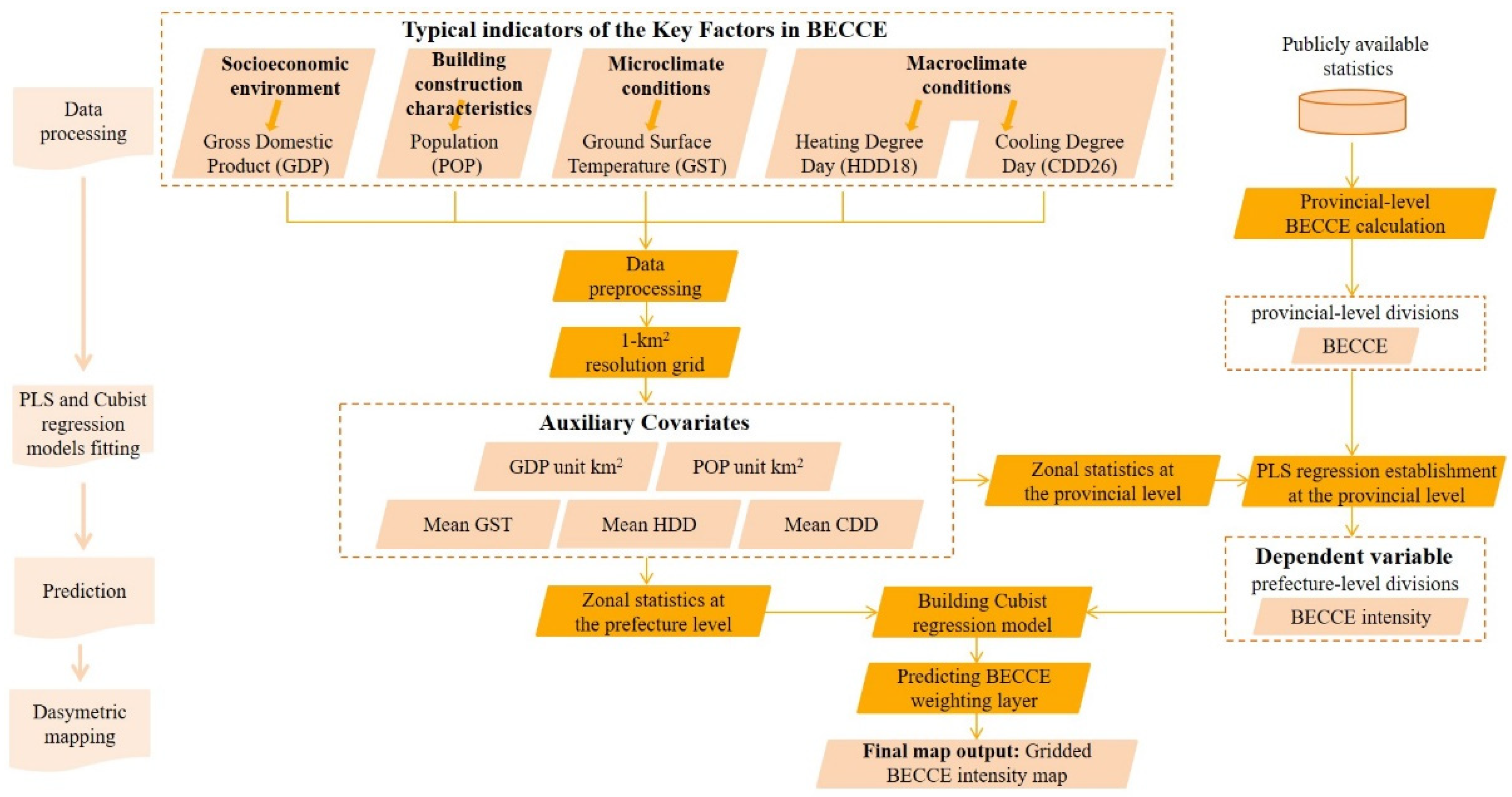
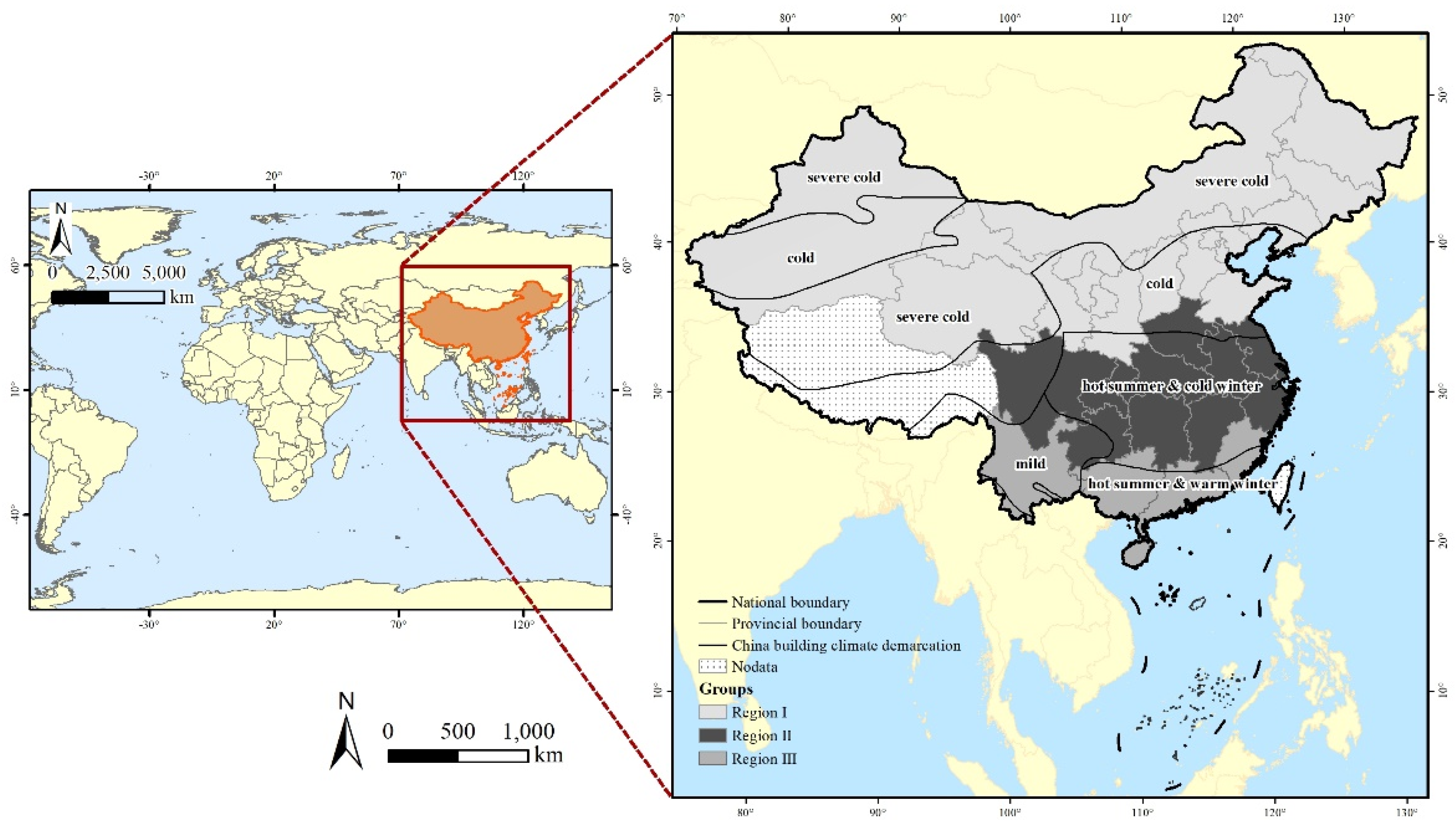
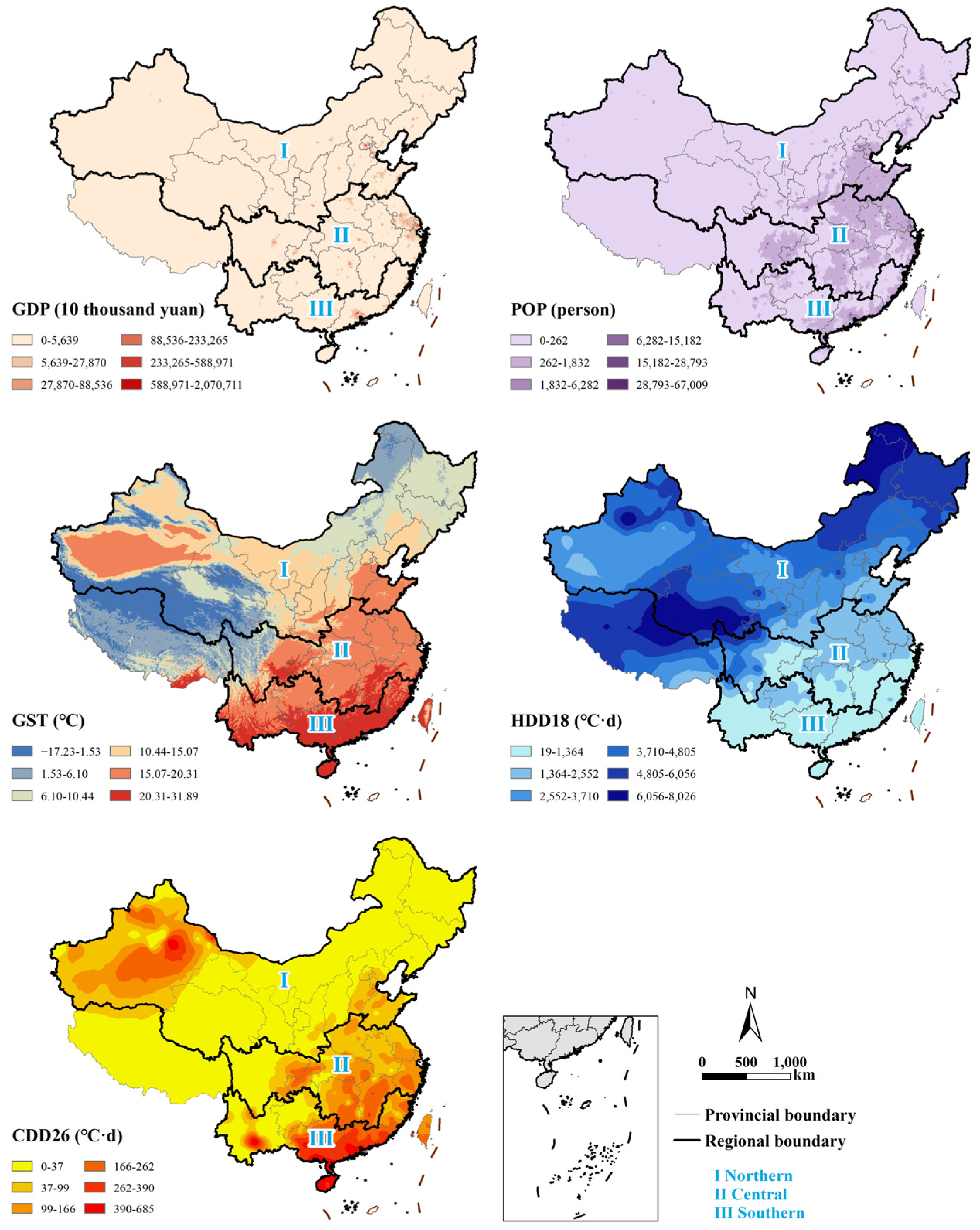


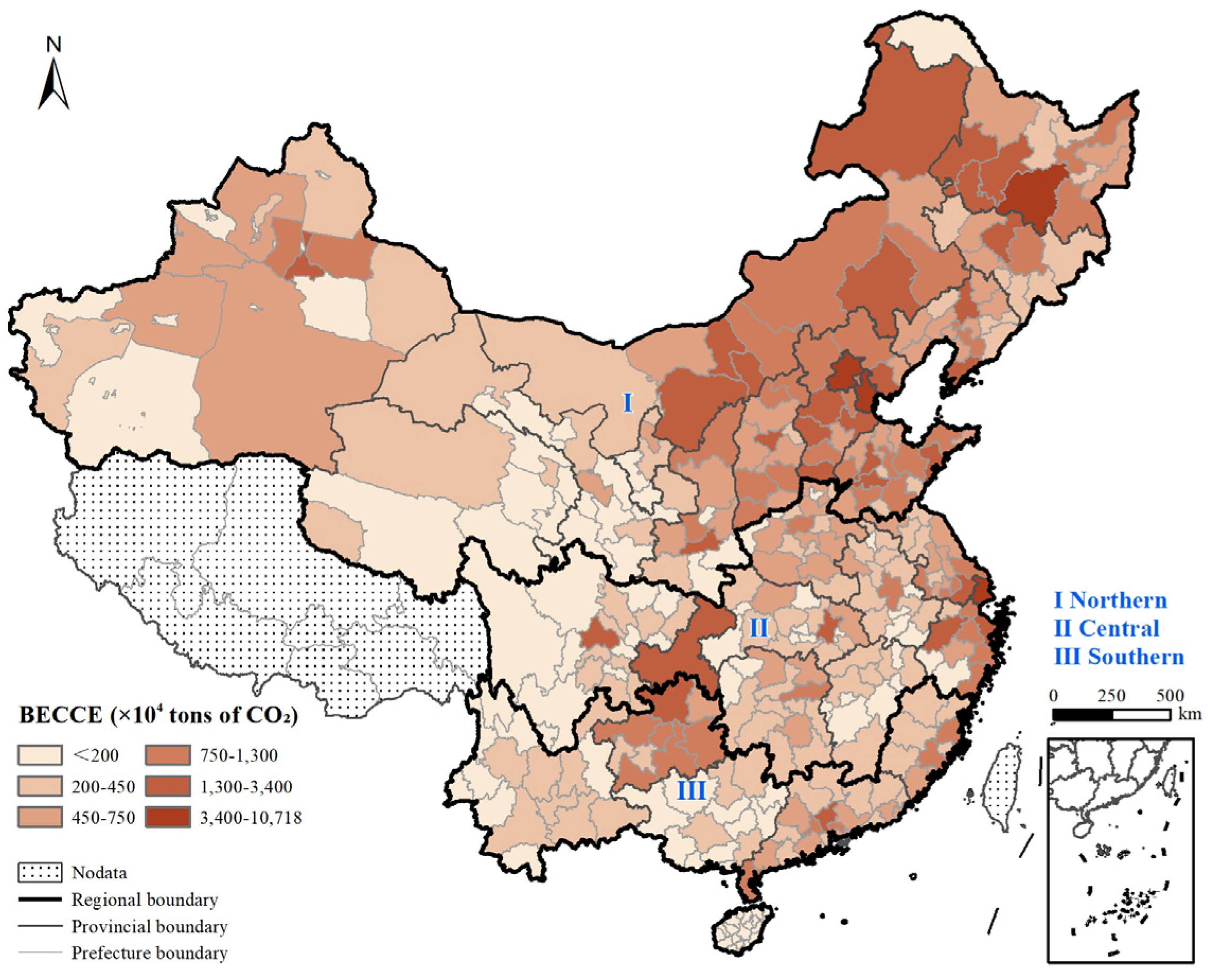
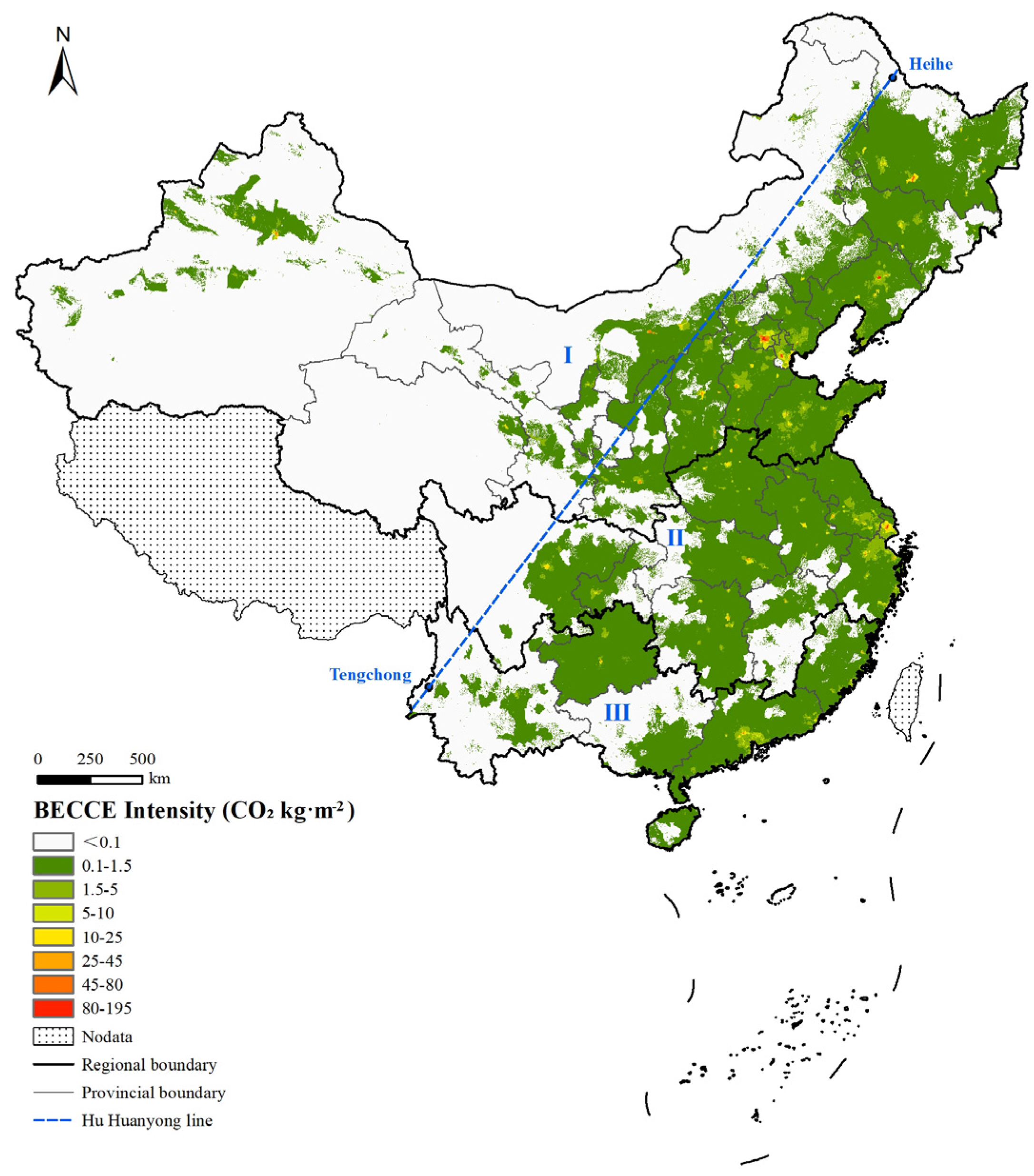

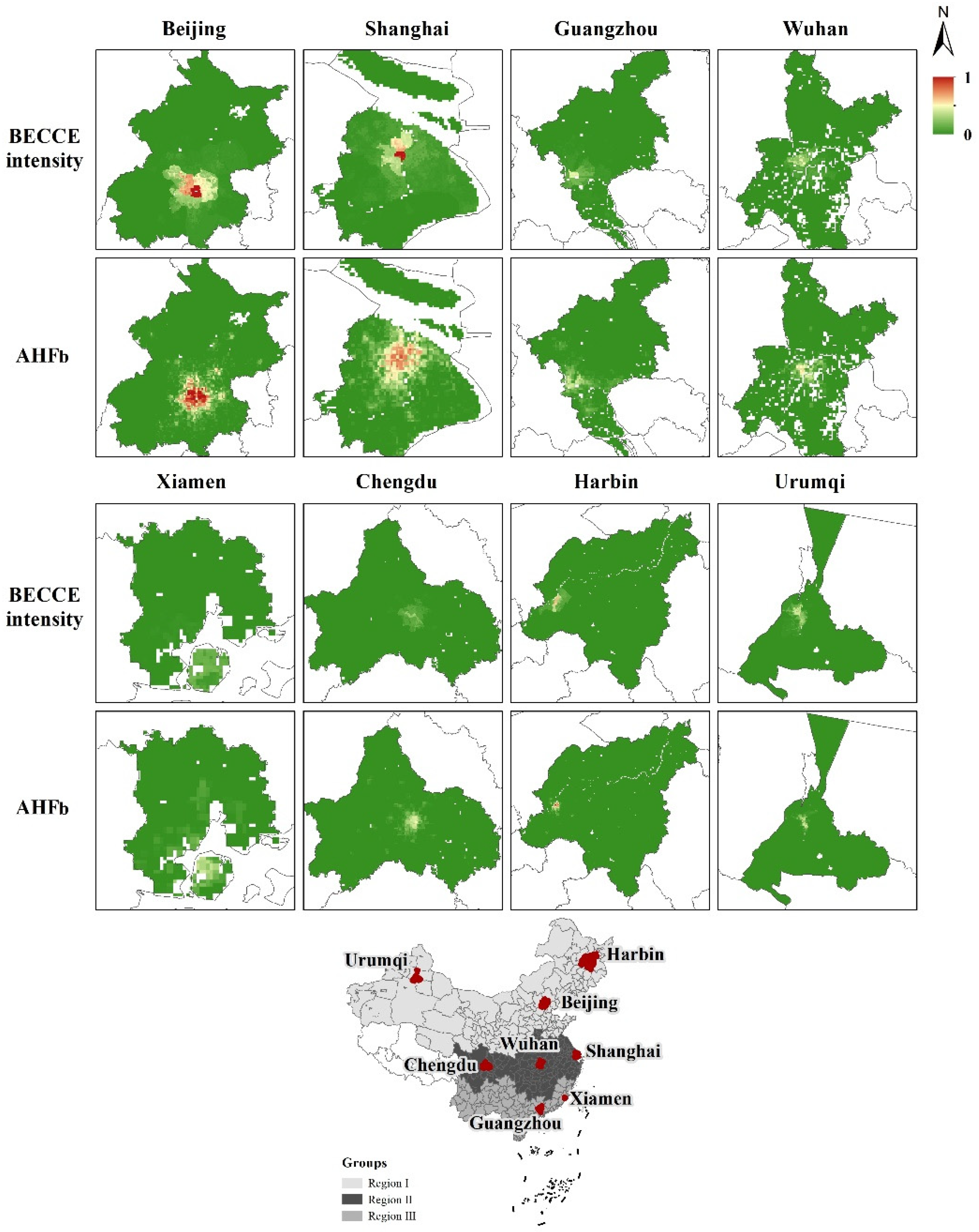
| Groups | PLS Regression Models | Adjusted R2 |
|---|---|---|
| Region I | BECCEI = 0.742 GDP + 0.220 POP + 0.045 GST + 1.855 HDD − 7.149 | 0.963 |
| Region II | BECCEI = 0.489 GDP + 0.699 POP + 0.001 GST + 0.188 HDD + 0.030 CDD − 1.573 | 0.961 |
| Region III | BECCEI = 0.335 GDP + 0.520 POP + 0.013 GST + 0.174 CDD − 0.677 | 0.804 |
| Data for Assessment | Number of Samples | Regression Models | Pearson’s R |
|---|---|---|---|
| Whole | 8,155,038 | AHFb = 0.184 BECCEI + 0.007 | 0.620 ** |
| Region I | 5,422,939 | AHFb = 0.176 BECCEI + 0.004 | 0.644 ** |
| Region II | 1,614,474 | AHFb = 0.201 BECCEI + 0.012 | 0.601 ** |
| Region III | 1,117,625 | AHFb = 0.268 BECCEI – 0.006 | 0.526 ** |
Publisher’s Note: MDPI stays neutral with regard to jurisdictional claims in published maps and institutional affiliations. |
© 2021 by the authors. Licensee MDPI, Basel, Switzerland. This article is an open access article distributed under the terms and conditions of the Creative Commons Attribution (CC BY) license (https://creativecommons.org/licenses/by/4.0/).
Share and Cite
Zhao, Z.; Yang, X.; Yan, H.; Huang, Y.; Zhang, G.; Lin, T.; Ye, H. Downscaling Building Energy Consumption Carbon Emissions by Machine Learning. Remote Sens. 2021, 13, 4346. https://doi.org/10.3390/rs13214346
Zhao Z, Yang X, Yan H, Huang Y, Zhang G, Lin T, Ye H. Downscaling Building Energy Consumption Carbon Emissions by Machine Learning. Remote Sensing. 2021; 13(21):4346. https://doi.org/10.3390/rs13214346
Chicago/Turabian StyleZhao, Zhuoqun, Xuchao Yang, Han Yan, Yiyi Huang, Guoqin Zhang, Tao Lin, and Hong Ye. 2021. "Downscaling Building Energy Consumption Carbon Emissions by Machine Learning" Remote Sensing 13, no. 21: 4346. https://doi.org/10.3390/rs13214346





